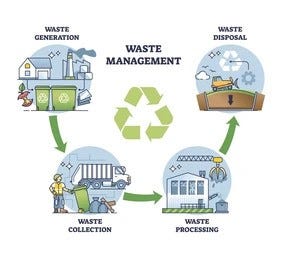Recycling Lives Services: Leading the Way in Liable Recycling
Wiki Article
Understanding the Classification and Handling of Numerous Sorts Of Waste
Effective waste monitoring is essential for environmental sustainability, requiring a thorough understanding of the category and handling of different waste types. House waste, industrial by-products, unsafe products, electronic refuse, and natural remnants each demand distinct procedures to ensure safety and minimize environmental damages.
House Waste
Family waste, encompassing a wide array of disposed of materials created from day-to-day living tasks, represents a substantial component of the general waste stream - recycling lives services. This group includes organic waste such as food scraps, backyard clippings, and paper products, together with not natural products like plastics, metals, and glass. The diverse nature of family waste demands effective classification and administration to minimize ecological impact and promote sustainable living methodsEffective house waste administration starts with partition at the source, promoting recycling, composting, and risk-free disposal. Organic waste, as an example, can be composted to create nutrient-rich dirt changes, decreasing land fill problem and enhancing soil health. Recyclable materials, consisting of paper, glass, and specific plastics, can be refined and repurposed, reducing and saving sources energy intake related to brand-new material production.
In addition, dangerous house waste such as batteries, electronic gadgets, and cleansing chemicals requires specialized taking care of to avoid dirt and water contamination. Public recognition campaigns and practical disposal alternatives play important duties in ensuring appropriate disposal and recycling of these products. By implementing robust waste reduction approaches and fostering community involvement, districts can substantially minimize the ecological impact of household waste.
Industrial Waste
Industrial waste, a significant factor to international waste generation, encompasses a diverse variety of materials created by production, building and construction, and various other commercial activities. This category includes spin-offs such as scrap metal, plastics, rubber, chemicals, and other residues. The structure and quantity of hazardous waste can differ dramatically relying on the sector and manufacturing procedures entailed. Reliable monitoring of commercial waste is critical for decreasing environmental impact and advertising lasting practices.The handling of industrial waste typically entails numerous procedures: collection, disposal, treatment, and partition. Collection systems are created to effectively gather waste products from different sources within a commercial operation. Partition is important, as it makes sure recyclable materials are divided from non-recyclable ones, which can be guided in the direction of proper recycling or disposal channels. Therapy processes, consisting of physical, chemical, and organic techniques, are utilized to decrease the poisoning, volume, and ecological effect of the waste. Finally, disposal approaches like landfilling or incineration are used for waste that can not be reused or treated.
Taking on techniques such as waste reduction, resource healing, and recycling can significantly minimize the worry of industrial waste on the setting, adding to more lasting commercial practices.
Hazardous Waste

Corrosive wastes can harm or destroy living materials and cells. Flammable wastes can conveniently fire up, posing fire dangers, while reactive wastes can trigger surges or launch hazardous gases upon call with other materials.
Effective unsafe waste administration entails several crucial practices: identification and partition of dangerous products, safe transportation and storage space, and appropriate treatment and disposal. Therapy methods may consist of chemical neutralization, incineration, and stabilization. Governing compliance is necessary, guided by frameworks such as the Resource Preservation and Healing Act navigate to this site (RCRA) in the United States, which ensures eco audio and secure monitoring of dangerous waste.
Digital Waste
Digital waste, often abbreviated as e-waste, represents an expanding obstacle in waste monitoring as a result of the rapid obsolescence of technology. This classification includes a wide variety of thrown out digital devices, including smartphones, computers, televisions, and family devices. The intricacy of go now e-waste exists in its make-up; these things have a mixture of useful materials such as gold and copper, along with harmful compounds like mercury, lead, and cadmium.Regulations and policies, such as the European Union's Waste Electric and Electronic Tools (WEEE) Directive, purpose to promote liable e-waste management. These plans mandate manufacturers to assist in the collection and recycling of digital products, therefore decreasing the worry on landfills and lessening ecological contamination.
Organic Waste
Organic waste, encompassing eco-friendly materials such as food scraps, lawn trimmings, and farming deposits, constitutes a substantial portion of the community strong waste stream. This kind of waste is noteworthy not just for its quantity yet also for its prospective ecological impact if not handled appropriately. Organic waste can decompose anaerobically in landfills, creating methane, a powerful greenhouse gas adding to environment change.Appropriate handling of natural waste includes a number of techniques. Additionally, diverting food waste from land fills via contribution programs can ease food instability while reducing waste.
Municipalities and services are progressively recognizing the significance of organic waste management. Applying thorough natural waste recycling programs not only mitigates ecological influences however likewise aligns with broader sustainability objectives, advertising a circular economic climate where resources are constantly reused and repurposed.
Final Thought
Efficient waste monitoring and environmental security demand a comprehensive understanding of the category and handling of numerous waste types. Executing ideal methods for each waste type makes sure secure and responsible waste administration techniques, inevitably contributing to the protection of environments and public wellness.Effective waste management is critical for ecological sustainability, calling for a thorough understanding of the classification and handling of various waste types.Home waste, including a wide selection of thrown out products created from day-to-day living activities, stands for a significant component of the overall waste stream.Industrial waste, a major contributor to global waste generation, encompasses a diverse range of materials produced by manufacturing, construction, and other industrial tasks (recycling lives services).Unsafe waste, a crucial worry in waste management, consists of products that pose significant threats wikipedia reference to human wellness and the setting due to their toxic, harsh, combustible, or responsive residential properties.Organic waste, including naturally degradable materials such as food scraps, yard trimmings, and farming deposits, makes up a significant portion of the metropolitan strong waste stream
Report this wiki page